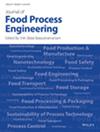Biodegradable monolayer film based on the collagen extracted from Oreochromis sp. processing byproducts blended with chitosan and assembled with PCL and PLA monolayers to form bilayers films
Abstract
The objective of the study is to develop and characterize biodegradable monolayer and bilayer films using collagen extracted from tilapia skin and scales (Oreochromis sp.) with chitosan in combination with biodegradable polyester; polylactic acid (PLA) or polycaprolactone (PCL). Collagen extraction was conducted with acetic acid (0.5 M). Monolayer films based on collagen and chitosan were formed by the casting process with a solution of chitosan (2% w/w) in 1.5% acetic acid, followed by the addition of skin collagen at concentrations of 0.5%, 1%, or 2% w/w, and dried at 45–50°C. The PLA and PCL films were made by compression molding. The films were characterized according to their appearance, structure, morphology, interaction with water, thermal stability, and mechanical and barrier properties. The results indicated that collagen from tilapia skin and scales yielded 36.5% and 2.57%, respectively. The results showed that adding chitosan increased the tensile strength but decreased the elongation of the films. An improvement in thermal stability was observed by increasing the proportion of collagen or chitosan, and it also influenced water solubility and water vapor permeability. Microscopy showed a crack-free interface between collagen and chitosan. The color of the films varied depending on the composition, highlighting the influence of chitosan in yellow and reddish tones. The bilayers with PLA had lower water vapor permeability and higher gloss compared to those with PCL. Finally, the developed films showed promising properties for their application in food packaging and promote the use of fishery waste.
Practical applications
The study aims to develop and characterize biodegradable monolayer and bilayer films using collagen extracted from tilapia skin and scales (Oreochromis sp.) combined with chitosan and biodegradable polyester such as polylactic acid or polycaprolactone. The practical applications of this research span a wide range of industrial fields. For instance, monolayer films could be used as sustainable food packaging, offering enhanced barrier properties and biodegradability, thus reducing the environmental impact of conventional packaging. Furthermore, bilayer films could find applications in the healthcare industry, such as controlled-release drug patches or dressings leveraging the antimicrobial properties of chitosan. This research also provides valuable insights into improving the mechanical, thermal, and barrier properties of biodegradable films, potentially leading to the production of more efficient and versatile materials for a variety of industrial applications.

 求助内容:
求助内容: 应助结果提醒方式:
应助结果提醒方式:


